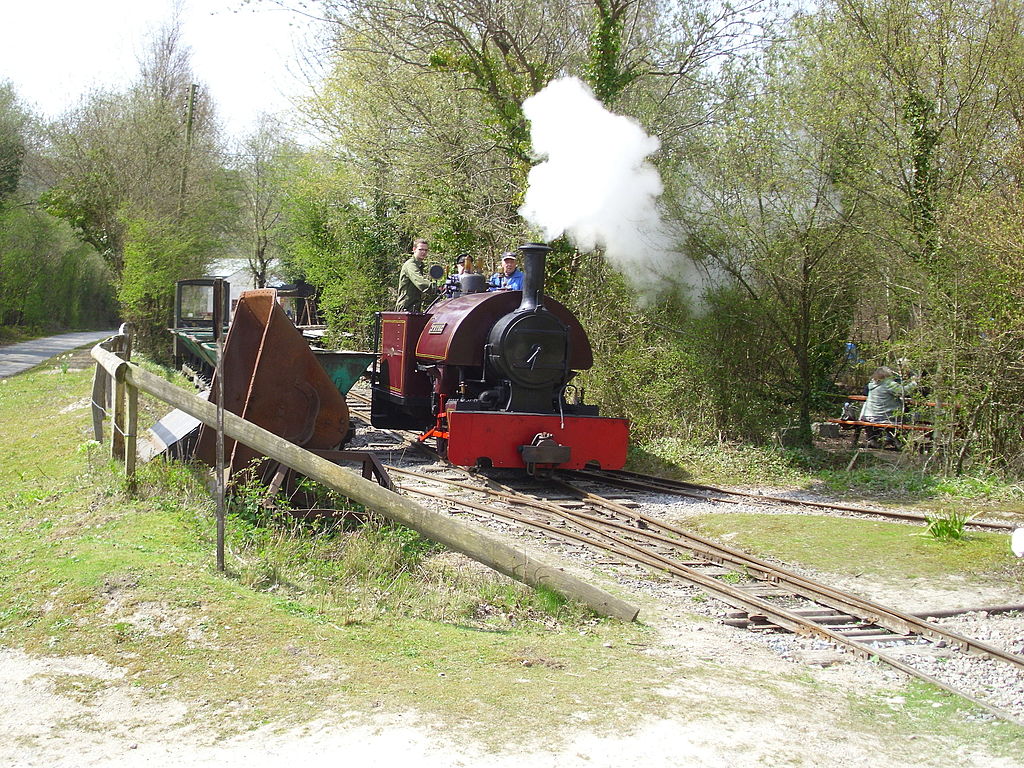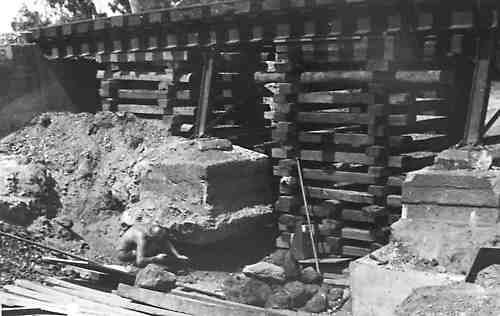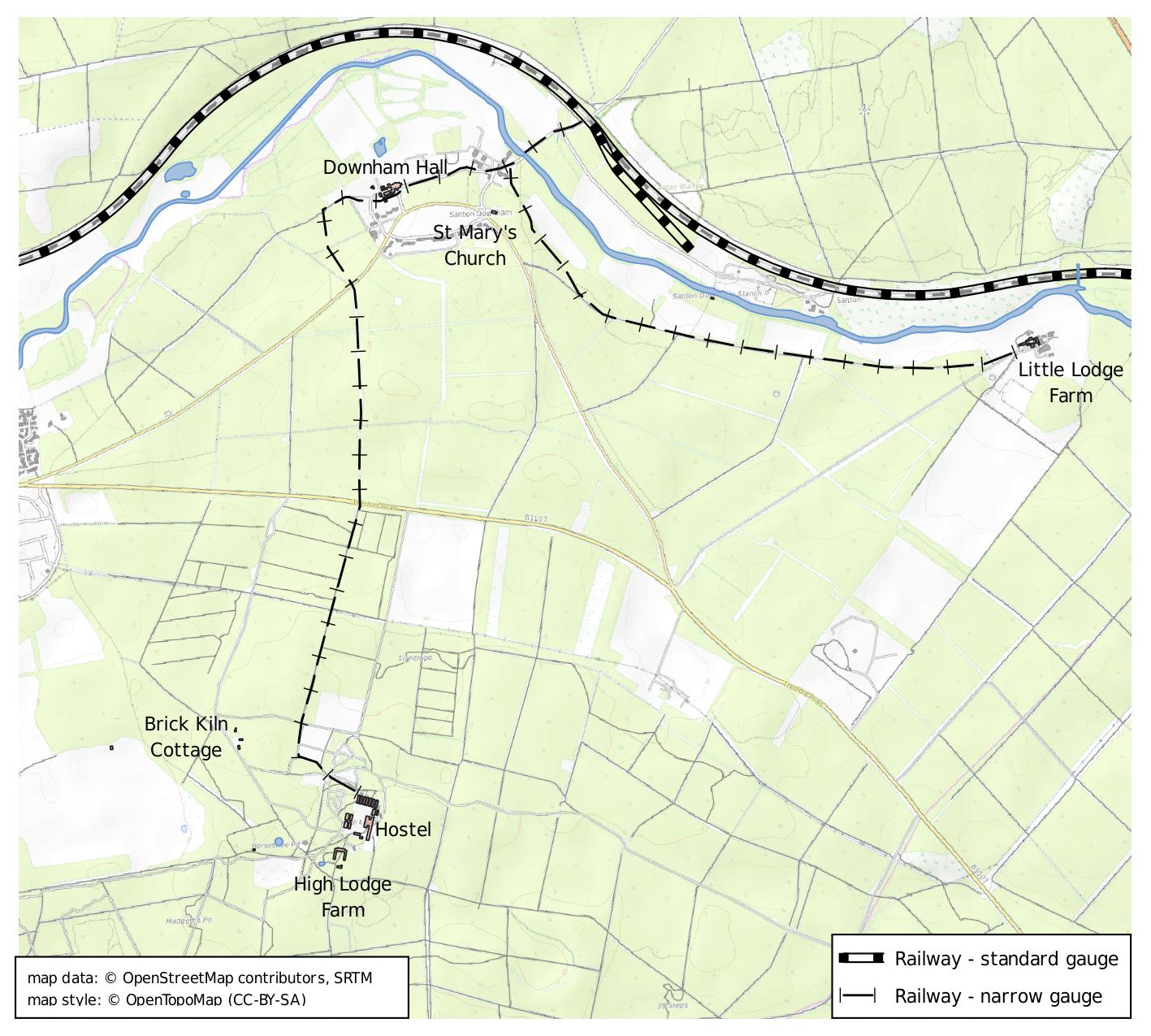



The Canadian Forestry Corps decided to use a light railway to move felled logs to their sawmill. The mill was constructed adjacent to the GER mainline railway.
The light railway was laid to 3 foot gauge, as used at other CFC operations in Britain.
Clearing the route of the light railway commenced in July 1918. At the same time arrangements were made to strengthen the bridge over the River Ouse to so as to carry the weight of the railway locomotive.
At least part of the light railway was ready for use by the end of October 1918 and transport of logs to the mill started on November 15th.
Owing to the soft nature of the ground near the river and its liability to floods, cribbing was necessary. This was reported to have stood the test of the locomotive and loaded trucks very well. Owing to the scattered nature of the timber at this operation, it was decided that the whole of the hauling of the logs to the Mill would be by light railway.
In the November 1918 monthly summary, it was reported that: The progress of laying steel through the bush operations at Downham Hall continues and many difficulties have been successfully overcome. The logs are transported to the Mill on log cars constructed by personnel of the Company and hauled by a locomotive. The steel is rapidly approaching the Brandon-Thetford road which it is proposed to cross to access the belt of timber lying to the south part of the operation.
On 7th November 1918, the West Suffolk County Council granted permission for the light railway to cross the Brandon to Thetford Main Road provided that the railway was laid at right angles to and level with the road surface; check rails were inserted to retain material on center in position which is to be made up with tarred granite; the outside margin to be made up with tarred material for a width of between 12 and 16 inches and 3 to 4″ in thickness; the military authority to indemnify the County Council for all claims and accidents; crossing to be removed and road re-instated when hauling of timber is complete.
A branch line to serve the POW camp was proposed in October 1918. The same month a plan was prepared showing the light railway line of the CFC over the private bridge and round to the mill, and also the track of the wooden built-up causeway for the light railway, also the track into the forest. Sadly this plan has not yet come to light!
The last reference to the railway in the CFC correspondence comes at the end of March 1919, when it is noted that The proprietors [of Downham Hall] now propose to take back the whole operation and to take over the sawmill, rails and pay the costs of the operation up to date.
Although there are records of three Bagnall engines being sent to Downham Hall, it appears that the line was for the most part operated by just one locomotive. According to the 126th Company correspondence files the valuation made at the close of Canadian operations references "Technical Equipments including mill machinery locomotive, rails etc." at a value of £9500.
W. G. Bagnall of Stafford supplied locomotives to the Canadian Forestry Corps and three of these 0-4-0 saddle tanks were recorded at High Lodge at various times.
According to The Industrial Railway Society, the three Bagnall locomotives were all built in 1919. No 2081 was supplied new to Downham Hall and transferred later in the year to 105 Company Canadian Forestry Corps in Dorset.
No 2085 arrived in Suffolk by July 1919 and was returned to the manufacturer before the end of the year.
No 2086 was at Downham Hall by September 1919. This loco was included in the sale of the timber operations to the Downham Syndicate on 10th December 1919. It was included in the closing sale of the syndicate in June 1922

As yet, we have found no evidence for the identity of the locomotive(s) used in the period from the line's opening in November 1918 until the arrival of the first Bagnall in 1919.
The line was lightly built, with no significant civil engineering works. As a result, it is difficult to be sure of its exact route. From the river bridge to the mill, the line probably followed the road. The level was maintained using crib work (essentially piles of logs forming an interlocking structure).

South of the river the route is much more conjectural, but following field surveys three potential routes have been identified. All three routes followed existing roads, tracks and gaps between the early plantations. All can be followed on the ground today.
After crossing the river, the line turned west to pass alongside the cottages, through the farmyard and then crossed in front of Downham Hall The line then climbed to run along (or beside) the road to Brandon. Turning southwards, the line crossed the Brandon-Thetford road and made its way to High Lodge following the route of the modern entrance drive. A branch line diverged immediately south of the river bridge and followed an almost level route to Little Lodge Farm.

This route would also have the line passing Downham Hall. It then continued west before turning in a southerly direction to take a direct route to High Lodge. This route crossed the minor road from Santon Downham to Brandon before making its way through he area know as Stonepits to cross the Brandon - Thetford road. It then followed what is now a division between two forestry compartments. As with Route 1, a branch line connected to Little Lodge Farm

The line turned south-eastwards from the river and proceeded to Little Lodge Farm. Part way along this route a second line to headed off to the south-west, along what is nowadays a footpath, before running along the old Elveden road to reach High Lodge
Which, if any, of these conjectured routes was the true course of the light railway is yet to be determined. Should further evidence come to light it will be included here
